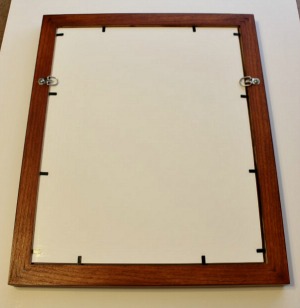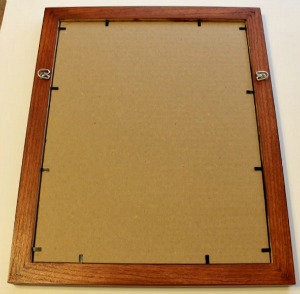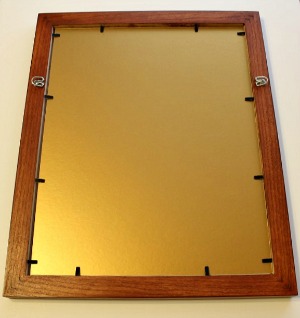Picture Frame Backing
Close the Deal
You've reached the point of closing up your frame. Picture frame backing is one of the final pieces to put in place - literally. It doesn't have to be complicated or expensive.
In fact, it can be very easy and wallet friendly.
Depending on what you're framing; you can use cardboard, standard foam board, acid free foam board, mat board, hard board, chip board, easel backs, or what the heck, you can even use wood.
There are a bunch of choices, so let's sort through them and figure out what you need for your project.
Deciding what Picture Frame Backing to Use
I make a lot of diploma frames.
Acid free foam board is important because It helps prevent yellowing and deterioration of the diplomas that are pressed up against it.
If you're framing a poster of KISS you scored at a garage sale, you can probably "risk it" with regular foam board or cardboard.
5 Questions to ask yourself when deciding what type of backing to use:
(click on questions to see possible answers)
- What am I framing, does it have sentimental or financial value?
- Based on question #1, does the item require acid free backing or not?
- Is it possible I will need to get "into the frame" again?
- How thick can the backing be and still fit in the rabbet and allow space for fastening it?
- How will I fasten the backing in place?
Foam Board, Cardboard and Mat Board
 Foam Board |
 Cardboard |
 Mat Board |
Foam Board
Cardboard
Mat Board
- Great in a pinch if: you don't have more than 1/16" space left in the rabbet for a backing board, if you're using a cardboard backer and want an acid free buffer between the cardboard and art work, if you simply don't have anything else on hand and need a backing quickly
- Can use scraps of mat board to make backing boards. Face out to show color and give a nicer look to the back of the frame.
- Acid free - even standard mat board, being roughly 97% acid free, will protect for decades
- A little bit more "challenging" to cut than foam board or cardboard, but you know that already....
|
My opinion is that foam board gives the DIYer the best of all worlds when it comes to picture frame backing. It's fairly cheap, its easy to work with, its sturdy and it offers an acid free option. Whatever method you decide upon, you'll need to fasten the backing board into the frame. I use an inexpensive Logan Flexible Point Driver. The time it saves and ease of using it make it a money saver if you plan on making frames on a regular basis. Flexi-points are also great because they allow you to quickly remove and replace the backing. For more options on picture framing hardware, check out the Picture Frame Hardware Page. |
Hard Board and Chip Board
Hard Board
Chip Board
Easel Backs
Easel backs for picture frames range in price from very cheap to fairly expensive. Are you in need of a quick or cheap solution? Are you working on a meaningful gift that requires something more professional?
Either way, they've got your back - sorry had to throw that in there!
Hardware
No matter what type of picture frame backing you choose, you will need to use some type of hardware to hold the frame sandwich together. I use the Logan flexi-gun shown below, but I started out using washers and screws.
Whatever your budget, time and desire calls for - it's not hard when it comes to simple picture frame jobs.
In the near future I will cover more advanced techniques like dust shields and complete sealing of the back of a frame.







Have a question or a comment? This space is for you! Leave it in the box below.